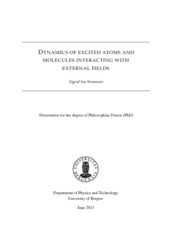| dc.contributor.author | Simonsen, Sigrid Ina | eng |
| dc.date.accessioned | 2014-01-09T14:01:09Z | |
| dc.date.available | 2014-01-09T14:01:09Z | |
| dc.date.issued | 2013-08-30 | eng |
| dc.identifier.isbn | 978-82-308-2358-3 | en_US |
| dc.identifier.uri | https://hdl.handle.net/1956/7662 | |
| dc.description.abstract | This thesis is a theoretical study of the behavior of electrons in atoms and molecules subjected to external electromagnetic fields. Three electronic systems have been central in this work, the atomic and quasimolecular Rydberg states and the carbon allotrope graphene. The exaggerated properties of the highly excited Rydberg atoms, such as long lifetime, large spatial extension and low binding energy make them excellent candidates for both theoretical and experimental considerations. The analytical solutions of the hydrogen atom in quantum mechanics provide a good description for most Rydberg atoms. This is exploited in the work presented in this thesis and the accompanying papers, where we show results of numerical computations on interacting Rydberg atoms, with and without the presence of radiating fields, as well as dynamic Rydberg wave packets influenced by a train of femtosecond laser pulses. In the final part of the thesis the optical process of high-order harmonic generation in an extended molecular structure, represented by graphene, is considered. Rydberg atoms have a large dipole moment due to the large average electronic radius in the atom, which leads to a very strong dipole-dipole coupling between interacting particles in a gas of cold Rydberg atoms. This interaction, which is dependent on the internuclear separation between the atoms, induces a shift in the energy levels, which again prohibits the excitation of more than one atom in the gas, an effect commonly known as the Rydberg blockade. A correlated behavior is observed for the intrashell transitions in mutually excited Rydberg atoms. The microwave field driven dynamics is significantly supressed for internuclear distances below a given conditional radius which scales linearly with the principal quantum number n. Such an entangled electronic behavior may open for the realization of quantum gates applied in quantum informatics. The long-range interaction of Rydberg atoms is dominated by the dipole-dipole terms. Nevertheless, the investigation of two interacting Rydberg atoms, without the influence of electromagnetic radiation, has shown that the lower order multipolar terms play a vital role in the energy shifts as well as for the electronic probability distributions. We found that the energy curves, when including all multipole orders, correspond to both repulsive and attractive states with a stronger repulsion than attraction. We also propose a laser assisted approach for stabilization of Rydberg gases by controlled transitions between such attractive and repulsive energy states. Single-electron ionization of a dynamic Rydberg wave packet confined within a single energy level has been investigated. The ionization probability of an intrashell Rydberg wave packet depends strongly on the degree of polarization. For a wave packet driven repeatedly between the circular (least polarized) state and the linear (most polarized) state by a rotating microwave field and subjected to a train of femtosecond laser pulses, the ionization probability will depend crucially on the laser repetition rate and number of pulses. The angular-resolved ionization probability and energy distribution in the continuum are also influenced by these parameters. The last part of the thesis is devoted to the study of high-order harmonic generation (HHG) in graphene. In the simple man’s model HHG can be described by an electron that is ionized and driven in an external field, after which it returns to the parent atom and recombines, emitting a high-energy photon with frequency that is a multiple of the incident laser frequency. We show that the harmonic spectra obtained from the interaction with linearly as well as circularly polarized femtosecond lasers yield harmonics up the classical limit for extended molecules. In contrast to diatomic molecules, the stable grid structure of graphene ensures that the harmonic generation cutoff remains constant with increasing signal power as the graphene diameter extends beyond the classical limit. Additionally, for circularly polarized lasers harmonics exceeding the classical predictions have been observed. | en_US |
| dc.language.iso | eng | eng |
| dc.publisher | The University of Bergen | en_US |
| dc.relation.haspart | Paper I: L. Sælen, S. I. Simonsen and J. P. Hansen, Interatom intrashell blockade, Physical Review A 83, 015401 (2011). The article is available here: <a href="http://hdl.handle.net/1956/7663" target="blank">http://hdl.handle.net/1956/7663</a> | en_US |
| dc.relation.haspart | Paper II: S. I. Simonsen, L. Kocbach and J. P. Hansen, Long-range interactions and state characteristics of interacting Rydberg atoms, Journal of Physics B 44, 165001 (2011). Full-text not available in BORA. The published version is available at: <a href="http://dx.doi.org/10.1088/0953-4075/44/16/165001" target="blank">http://dx.doi.org/10.1088/0953-4075/44/16/165001</a> | en_US |
| dc.relation.haspart | Paper III: S. I. Simonsen, S. A. Sørngård, M. Førre and J. P. Hansen, Femtosecond-pulsetrain ionization of Rydberg wave packets, Physical Review A 86, 043423 (2012). The article is available here: <a href="http://hdl.handle.net/1956/7449" target="blank">http://hdl.handle.net/1956/7449</a> | en_US |
| dc.relation.haspart | Paper IV: S. A. Sørngård, S. I. Simonsen and J. P. Hansen, High-order harmonic generation from graphene: Strong attosecond pulses with arbitrary polarization, Physical Review A 87, 053803 (2013). The article is available here: <a href="http://hdl.handle.net/1956/7450" target="blank">http://hdl.handle.net/1956/7450</a> | en_US |
| dc.relation.haspart | Paper V: S. I. Simonsen, S. A. Sørngård, M. Førre and J. P. Hansen, High-order harmonic generation in graphene flakes exposed to circularly polarized femtosecond pulses, submitted to Journal of Physics B, May 2013. Full-text not available in BORA. | en_US |
| dc.title | Dynamics of excited atoms and molecules interacting with external fields | en_US |
| dc.type | Doctoral thesis | |
| dc.rights.holder | Copyright the author. All rights reserved | en_US |
